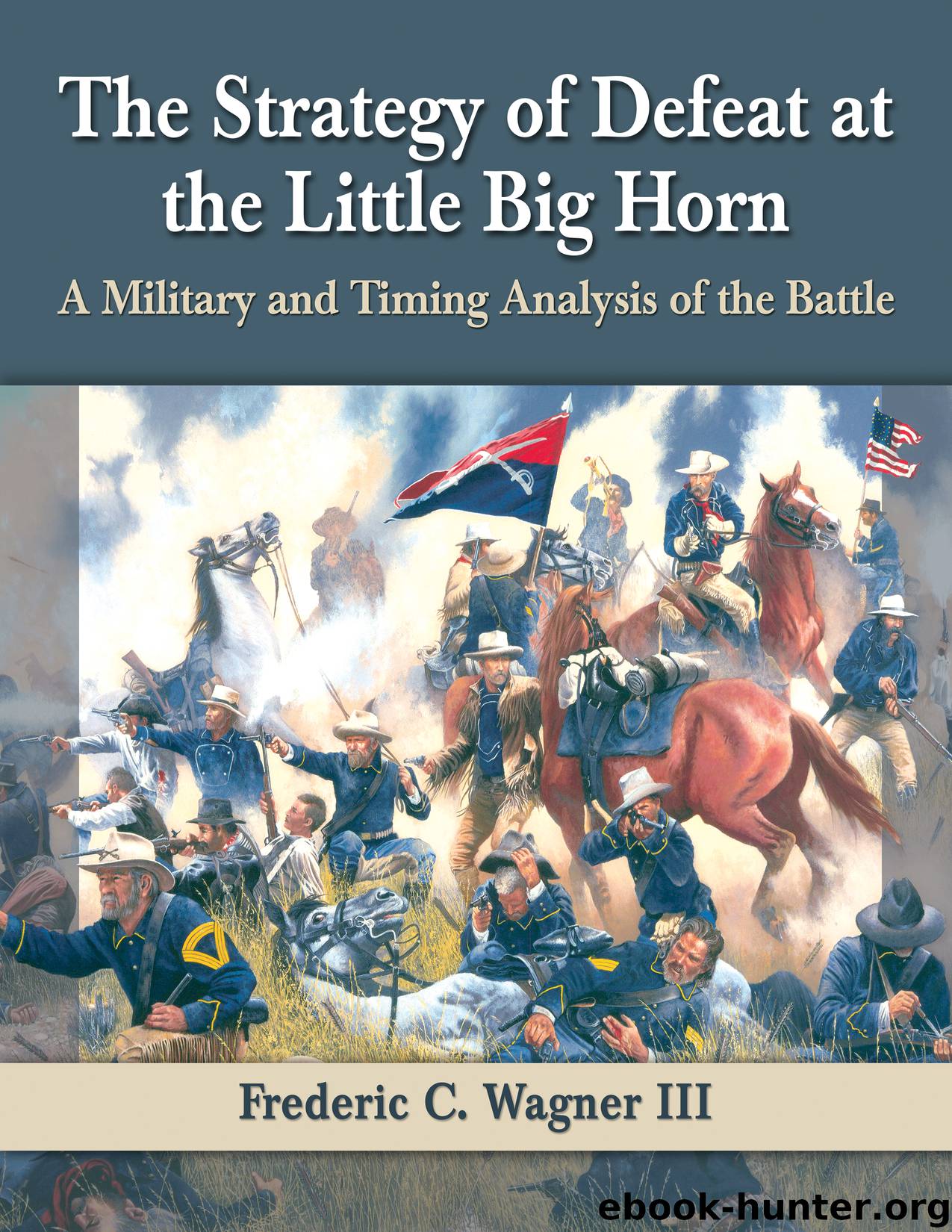The Strategy of Defeat at the Little Big Horn by Frederic C. Wagner III

Author:Frederic C. Wagner, III
Language: eng
Format: epub
Publisher: McFarland
Published: 2015-11-04T16:00:00+00:00
13
* * *
Ford B: Attack or Reconnaissance
References:
Timeline R—From 3,411 to Ford B and Volley Firing; 1:38 p.m.–3:07 p.m.
W—Warriors; 1:02 p.m.–5:17 p.m.
***
Once atop Luce Ridge, Custer’s precise route and objective become even greater enigmas; route and events have always been in question, starting from the first hours after the discovery of the debacle. Beyond Luce and Nye-Cartwright ridges, Custer’s trail becomes clearer, and of course we know where his command wound up, though whether or not he went farther, then backtracked, is still not immutable fact. Even the shrewdest of immediate observers was befuddled. At the end of the July 4 letter to his wife, Benteen wrote, “The latest and probably correct account of the battle is that none of Custer’s command got into the village at all.”1 Benteen’s opinion had changed, probably during a hiatus in the writing of the letter, for a little earlier in the same correspondence, he stated, “I am of the opinion that nearly—if not all of the five companies got into the village—but were driven out immediately.”2 His opinion changed again, in all likelihood the result of constant discussions and theorizing, for at the inquiry in February 1879, Benteen admitted at first he thought Custer had gone down to Ford B, but by the time of the inquiry he had changed his mind, feeling Custer never went there. From his testimony it seems he believed Custer cut straight across Luce and Nye-Cartwright ridges.3 This opinion now remained consistent throughout Benteen’s remaining years and in a January 16, 1892, letter to Goldin, Benteen agreed with Ed Godfrey’s theory of Custer’s route.4 Unlike Benteen’s testimony at the Reno inquiry, Godfrey said he thought Custer had attempted to cross at Ford B, though he found no evidence of specific fighting.5 Reno’s defense counsel brought up the point the shod horse tracks seen at the ford might have been made when Indians drove captured army horses across the river6 and while conceivable, it must be remembered the Indian activity after the Custer command had been destroyed could very easily have obliterated any tracks west or south of the Luce/Nye-Cartwright complex as the hostiles rode toward the Benteen and Reno battalions.
Confusion in 1886 was no different than it was 10 years earlier or 137 years later. As Godfrey walked the field with an old antagonist, Gall, the soldier asked the warrior about Custer’s route.
On the battle-field in 1886, Chief Gall indicated Custer’s route to me, and it then flashed upon me that I myself had seen Custer’s trail. On June 28, while we were burying the dead, I asked Major Reno’s permission to go on the high ridge east or back of the field to look for tracks of shod horses to ascertain if some of the command might not have escaped. When I reached the ridge I saw this trail, and wondered who could have made it.7
Download
This site does not store any files on its server. We only index and link to content provided by other sites. Please contact the content providers to delete copyright contents if any and email us, we'll remove relevant links or contents immediately.
| African-American Studies | Asian American Studies |
| Disabled | Ethnic Studies |
| Hispanic American Studies | LGBT |
| Minority Studies | Native American Studies |
Cecilia; Or, Memoirs of an Heiress — Volume 1 by Fanny Burney(32491)
Cecilia; Or, Memoirs of an Heiress — Volume 2 by Fanny Burney(31909)
Cecilia; Or, Memoirs of an Heiress — Volume 3 by Fanny Burney(31887)
The Great Music City by Andrea Baker(31754)
We're Going to Need More Wine by Gabrielle Union(19001)
All the Missing Girls by Megan Miranda(15764)
Pimp by Iceberg Slim(14433)
Bombshells: Glamour Girls of a Lifetime by Sullivan Steve(14019)
For the Love of Europe by Rick Steves(13505)
Talking to Strangers by Malcolm Gladwell(13284)
Norse Mythology by Gaiman Neil(13271)
Fifty Shades Freed by E L James(13185)
Mindhunter: Inside the FBI's Elite Serial Crime Unit by John E. Douglas & Mark Olshaker(9259)
Crazy Rich Asians by Kevin Kwan(9216)
The Lost Art of Listening by Michael P. Nichols(7452)
Enlightenment Now: The Case for Reason, Science, Humanism, and Progress by Steven Pinker(7270)
The Four Agreements by Don Miguel Ruiz(6695)
Bad Blood by John Carreyrou(6580)
Weapons of Math Destruction by Cathy O'Neil(6206)
